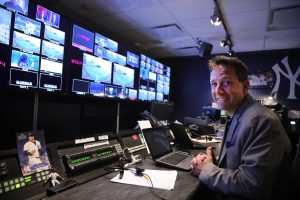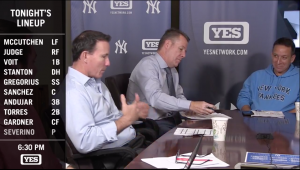As MLB Opening Day Nears, YES Network Thrives on Synergy and Collaboration
Studio programming and game production go hand in hand
Story Highlights
As the New York Yankees wrap up Spring Training and embark on their latest quest for the franchise’s 28th World Series, YES Network is eyeing another successful season from its headquarters in Stamford, CT. The offseason has been a busy one for both the men in pinstripes and the people who put them on the air, but, as some things change, others remain the same. In their 18th season at the network (their 20th in the industry), YES Network’s Jared Boshnack, coordinating producer, studio, and Bill Boland, lead game producer, have stayed committed to a heavy diet of communication, cooperation, and interconnectivity.
“We know each other so well that we know when to follow up on something that’s important or when to just gently nudge,” says Boshnack. “Right now, we’re ready to go, like the support staff, the players, and everybody else that’s associated with baseball in any capacity. You get excited for Opening Day. Somewhere around July, we still love what we do, but a lot of other people lose this [connection] since it’s a long season.”
The Meshing of Two Departments
The symbiosis between Boshnack’s studio programming and Boland’s production of the television broadcast has brought synergy to the two camps. Although they plan their respective chunks of the day independently, there is always a constant flow of collaboration.

Jared Boshnack and Bill Boland have racked up 24 Emmys for their studio and game production since 2003. (Photo: E.H. Wallop/YES Network)
“I’ll look at his rundown, and, if I see something that’s late in his show and right at the beginning of my show, we’ll say, Hey, would you mind moving that so that it’s not repeated content,” says Boland. “Even though we start the day separately with our own ideas of our own shows, we’ll talk throughout the day.”
For the work that goes on inside the network’s signature production truck, Game Creek Video’s Yogi, he blocks off at least two hours to scavenge through social media and other resources to determine what’s going on around the league.
“I’ll listen to sound [of interview clips from the previous game on the YES Network website] in the morning, then format my open and communicate it with my crew,” he says. “I get to the stadium between 1 and 2 p.m., and I’m there until 10:30 to 11 p.m.”
On the studio side, planning for the pregame show is a stringent process. With a 7 p.m. first pitch, Boshnack is in the building at 3:00 p.m., crafting the script that will set the table for that night’s game. Although there is a formatted structure for the show, he can relax a bit after the final pitch and approach the game recap with spontaneity.
“I get on a half hour before [Bill], and I stay an hour afterwards,” he says. “I get the best of both worlds, because we turn the page and the postgame is all free-flowing. He may be doing the game for the two- to three-hour range, but what’s happening during the broadcast is our canvas.”
Balancing Improvisation and a Scripted Plan
The duo’s diligent preparation makes for a successful slate of day-long entertainment, but the magic happens when Boshnack and Boland adapt on the fly.
“The producing aspect of it is a lot more fast-paced because you have all of this time to get things in,” says Boshnack. “You’re talking about flashbacks, roll-ins, etc.”
In addition to prepackaged content developed before the action starts, Boland will throw it over to the studio crew during the fourth and seventh innings for live, sponsored look-ins at the latest news, notes, and updates from games being played simultaneously. When breaking news occurs, they rely on working with each other.
“There are times when bigger baseball news breaks and it’s not the fourth or seventh inning,” notes Boland. “There’s an [an audio channel for Jared] that’s open at all times. That training comes way back from ABC when we worked on the college-football halftime show. We were the ones cutting in to four different regions of the country at one time.”
Digital platforms that have become integrated with the linear telecast receive their fair share of exposure as well. For example, Boshnack’s involvement with the Facebook Live show will get airtime on Boland’s in-game broadcasts.
“On the game side, we’ll plug that the Facebook Live show is happening soon,” says Boland. “There was a time where we experimented with a three-man booth, and Kevin Sullivan [director, digital media,] did a show with [analyst and former Yankees pitcher] David Cone. It’s a balance, because you don’t want to tell your whole audience to go away, but all of [our younger viewers] have multiple screens.”
Whether there’s a plan of attack or decisions are made off-the-cuff, there is a sense of continuity that provides uninterrupted content from both sides of the operation.
“When you turn on Yankees Batting Practice Today at 6 p.m. or even [The] Michael Kay [Show] before that, one show flows into the next show and into the next one,” says Boland. “The interaction between the game and the studio is seamless in that we’ll follow up storylines that they do in their show and put it in ours. [Programming] flows through the whole day.”
What’s New in 2019
Given all the new creations of last season, the YES Network is looking to build on the experience gained in 2018. From an operations perspective, all home games at Yankee Stadium were captured by 16 Sony HDC-4300 cameras with complete super-slo-mo playback ranging from 2X to 8X. After an entire year with this technology, Boland and his team want to expand its use.
“It’s really cool to have as a producer, but you can’t get trapped in it, because baseball is a live sport,” he explains. “If a guy is going first to third, you’re going to show that in real time. If the play is close at third or second, we have options to make that decision instantly. We’re excited to be able to build off of the fact that we have [super-slo-mo cameras] from last year.”
In addition, YES Network will alter some on-screen graphics, including a more subtle and less obtrusive PitchCast strike zone, and also will incorporate context into sabermetrics and analytics on StatCast. These improvements will be aided by MLB’s Elliot Weiss, senior coordinating producer, broadcast products and services, and Ryan Zander, VP, broadcast products and services.
“We’ve sort of been experiments for [MLB] as this process has gone on,” Boland explains, “but they make changes according to what we want. That part’s exciting because we’ll be able to tell more stories that are stats-based while making sense to the viewer.”
The talent in the booth will have a somewhat new look with the departure of former Yankees hurler Al Leiter. After coming out of retirement, Ken Singleton is back in a reduced role, doing a majority of his work on road games in Baltimore. The voices of Michael Kay, Cone, and former Yankees outfielder Paul O’Neill are back in full strength.
The studio portion has also made strides in explaining the more nuanced details of the game to the fan. Flash Focus, starring analyst and former Yankees catcher John Flaherty, will take a deep dive into the art of catching, including discussions on framing, blocking, pitcher positioning on the mound, and pitch sequences.
“A large portion of our fan base still is trying to understand and learn,” says Boshnack. “It’s up to us make to make it more digestible.”
Additional programming will honor both national and baseball-centric holidays (Jackie Robinson Day, Mother’s Day, Memorial Day, Fourth of July, and Father’s Day) and celebrate some of the most notable anniversaries in Yankees history: for example, the 1999 and 2009 World Series teams, Cone’s perfect game, the 10th anniversary of Hope Week, the death of captain Thurman Munson, and the 1949 divisional race against the Boston Red Sox.
Special occasions in the 2019 season that involve the Yankees and the city of New York will be commemorated as well, including features on the 50th anniversary of the Stonewall Riots, the 73rd Old Timers’ Day, coverage of the Yankees’ two-game series in London with the help of clubhouse reporter Meredith Marakovits and play-by-play/host/reporter Ryan Ruocco, and exclusive reports by analyst Jack Curry from Cooperstown during Mariano Rivera’s and Mike Mussina’s inductions into the National Baseball Hall of Fame.
As fans indulge in a full menu of new offerings, the physical set of the YES Network studio will continue its design evolution.
“It’s a much deeper and wider set, so we use our jib camera that gives a nice sense of depth, and [Lead Director] Mike Cooney does a really nice job of that,” says Boshnack. “We’ll continue to add to the studio, but we’ve done a lot already over the last two years that allowed a lot of the innovation and the technology that we needed to get us to where we are today.”
All of these new projects are conceived, started, and supported by the man at the top. “We consult a lot with [President of Production/Programming] John J. Filippeli,” says Boshnack. “He is integral to what we want to accomplish because he gives us the resources and understands us well enough that he lets us do our thing, but also is able to give us feedback when necessary.”
‘Power and Versatility’: The Storylines of the Season
After a tumultuous winter that saw star-studded outfielder Bryce Harper join the Philadelphia Phillies and hot-corner aficionado Manny Machado head west to San Diego, the Bronx Bombers countered with a handful of moves and acquisitions of their own. As the borough buzzes with tons of storylines (the signings of Troy Tulowitzki/DJ LeMahieu/James Paxton/Adam Ottavino, the youth movement led by Gleyber Torres, and the wave of power headlined by Aaron Judge and Giancarlo Stanton), the YES Network is doing all it can to highlight the ballplayers and the tales that surround them.

Boshnack assumed Boland’s former role of studio coordinating producer in 2010 after joining the team in the truck as lead game producer. (Photo: E.H. Wallop/YES Network)
Marakovits is spearheading an effort to paint a better picture of who the players are away from the diamond in a segment called “One for Three,” a one-on-one conversation that comes with a side of three specific questions.
“I want to, at least twice a week or once per series, look into getting an interview that tells us a little something that we don’t know about someone that’s on the Yankees or someone from the opponent,” says Boshnack. “We want to bring as much of the outer layers to the game that the fan isn’t aware of.”
With the same initiative in mind, accounts on social media will play their role in presenting candid moments of the on-air personalities. The Facebook Live show will act as an appetizer before every series, but, on Instagram, IGTV will give sneak peeks behind the scenes at the Stamford studios with studio anchor Bob Lorenz and the others.
“[It’s about doing] anything we can to satiate our audience while also piquing the interest and seeing if they want more,” says Boshnack. “We want to also give them a reason to tie back in and watch a lot of the long-form stuff.”
On linear television, the Yankees Batting Practice Show (produced by Josh Isaac and hosted by a rotating trio of Chris Shearn, Nancy Newman, and Michael Grady) will emphasize the sheer strength of the lineup by showcasing home-run blasts inside the cage.
“As far as the storylines go, there are a million of them,” says Boland. “Put YES on, put the remote down, and settle in for the night.
Moving Forward by Looking Back
Boshnack and Boland’s long-lasting relationship has inspired two groups of professionals who are able to perform in sync with each other.
“If there are games going on and there’s something happening, we have [Graphics Coordinator] Sean Sullivan or [Senior Writer] Glen Giangrande in the studio communicating to the truck and [Graphics Producer] Luke Miller,” says Boshnack. “They’re talking back and forth, and they know it much quicker than [workers] two generations before them [would] know it. Everybody is up to speed faster, and it allows us to get things done.”
Besides creating a network of determined workers, Boshnack and Boland can take credit for a large part of the regional sports network’s foundation. Since 2003, the Yankees flagship station has earned 24 Emmy Awards for studio programming and game coverage (in addition to a number of nominations in 2019). They have been part of the network’s highest moments (the final seasons of Derek Jeter and Rivera) as well as its lowest (the deaths of owner George Steinbrenner and 10-time World Series champion Yogi Berra). Through the highs and the lows, the YES Network has fostered a feeling of family.
“I’m most proud of the way that we mobilize,” says Boshnack. “We truly are a family, and, like most families, there are days where you really want to spend time with them and days where you want some space. But I will say that, when there are big moments, this group collectively rises to the challenge as well as any I’ve been around.”
Our 18th season begins today on YES! So proud. @YESNetwork pic.twitter.com/fhLCTyxX4p
— bill boland (@boles8) February 25, 2019
For Boland, a sense of pride comes with the start of every season and the fact that relishing the past can lead to greater success in the future.
“I saw the YES camera right next to the cage in Tampa [during Spring Training] and took a picture of it,” he says. “[Jared and I] didn’t do it ourselves, but we helped build this place from day one, and it means a lot. It has become one of the best regional sports networks, and I have tremendous pride in everything we do.”

